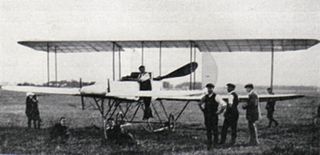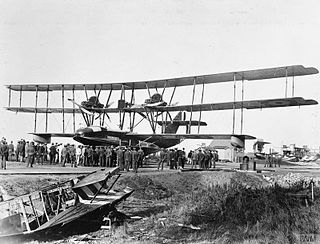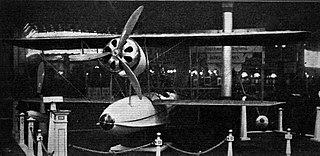
Blackburn Aircraft Limited was a British aircraft manufacturer from 1914 to 1963 that concentrated mainly on naval and maritime aircraft.

Early flying machines include all forms of aircraft studied or constructed before the development of the modern aeroplane by 1910. The story of modern flight begins more than a century before the first successful manned aeroplane, and the earliest aircraft thousands of years before.
The 1911 Curtiss Model D was an early United States pusher aircraft with the engine and propeller behind the pilot's seat. It was among the first aircraft in the world to be built in any quantity, during an era of trial-and-error development and equally important parallel technical development in internal combustion engine technologies.

The Handley Page Heyford was a twin-engine biplane bomber designed and produced by the British aircraft manufacturer Handley Page. It holds the distinction of being the last biplane heavy bomber to be operated by the Royal Air Force (RAF).

The S.E.1 was an experimental aircraft built at the Army Balloon Factory at Farnborough in 1911. Its place in aviation history is mainly that it was the first in the series of Royal Aircraft Factory designs - several of which played an important role in World War I.
The Green Engine Co was a British engine company founded by Gustavus Green in Bexhill to sell engines of his design. He flourished especially as a designer of aeroplane engines during the first two decades of the 20th century. The engines were actually manufactured by the Aster Engineering Company.

The British Army Aeroplane No 1 or sometimes Cody 1 was a biplane built by Samuel Franklin Cody in 1907 at the Army Balloon Factory at Farnborough. It made the first recognised powered and sustained flight in the United Kingdom on 16 October 1908.

The Felixstowe F.4 Fury, also known as the Porte Super-Baby, was a large British, five-engined triplane flying-boat designed by John Cyril Porte at the Seaplane Experimental Station, Felixstowe, inspired by the Wanamaker Triplane/Curtiss Model T. At the time the Fury was the largest seaplane in the world, the largest British aircraft, and the first aircraft controlled successfully by servo-assisted means.
Captain Horatio Claude Barber (1875–1964) was an early British aviation pioneer and First World War flight instructor. In 1911 he flew the first cargo flight in Britain, transporting electric light bulbs from Shoreham to Hove. He was also the first person in Great Britain to gain an aeronautical degree.
The Handley Page Type B was an unusual single-engined pusher biplane built by Handley Page at the commission of a Liverpool patent agent. Damaged before its first flight, Handley Page disowned it, but it was rebuilt and flew for a time in 1910 as the Planes Limited Biplane.

The Cody V was a single-engined biplane built by the British-based American aviation pioneer Samuel Franklin Cody in 1912. It was built from the remains of two of Cody's earlier aircraft, and won the 1912 British Military Aeroplane Competition, with two aircraft being purchased for the Royal Flying Corps. It was abandoned after the mid air disintegration of one of the aircraft in April 1913.

The Cody IV monoplane was a single-engined monoplane designed and built by the American-born but British-based aviation pioneer Samuel Franklin Cody in 1912. It was intended for entry into the 1912 British Military Aeroplane Competition, but was wrecked in a crash before the start of the competition.
The Norman Thompson Flight Company was a British aircraft manufacturer specialising in the construction of flying boats. It was formed as the White and Thompson Company in 1912, and designed and built the Norman Thompson NT.4 patrol aircraft and the N.T.2B flying boat trainer for the Royal Naval Air Service during the First World War, but production problems led to the company entering receivership in 1918, being liquidated in 1919.

The Hillson Bi-mono was a British experimental aircraft of the 1940s. It was designed to test the idea of "slip-wings", where the aircraft could take off as a biplane, jettison the upper, disposable wing, and continue flying as a monoplane. A single example was built, which successfully demonstrated jettisoning of the slip wing in flight.

The Cody Michelin Cup Biplane was an experimental aircraft designed and built in Britain during 1910 by Samuel Franklin Cody, a prominent showman and aviation pioneer. Cody had worked with the British Army on experiments with man-lifting kites and in October 1908 had successfully built and flown the British Army Aeroplane No 1, making the first officially verified powered flight in the United Kingdom. Cody broke the existing endurance record twice in the aircraft, the second flight, made on 31 December 1910, winning him the Michelin Cup for the longest-lasting flight made over a closed circuit in the United Kingdom before the end of the year.

Wing Commander Harold Blackburn, MC, AFC was a British aviation pioneer. Blackburn was the first pilot to carry newspapers for commercial sale by air and on 22 July 1914 piloted the first scheduled airline service in Great Britain.

The Pemberton-Billing P.B.1, sometimes known as the Supermarine, was a 1910s British single-seat flying-boat built by Pemberton-Billing Limited, which later became the Supermarine Aviation Works. Only one P.B.1 was built, and it never flew any distance further than a hop.

The pioneer era of aviation was the period of aviation history between the first successful powered flight, generally accepted to have been made by the Wright Brothers on 17 December 1903, and the outbreak of the First World War in August 1914.
The Aeronautical Syndicate Limited (ASL) was one of the earliest aeroplane manufacturers. A British company, it was founded in 1909 by the investor Horatio Barber and engineers William Oke Manning and Howard T. Wright. Initially located in Battersea, London, the business soon relocated to Larkhill on Salisbury Plain. It later moved to the Aeronautical Syndicate Flying School, Hendon. The company closed in 1912.














